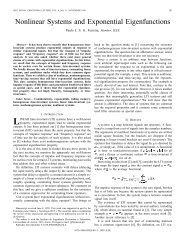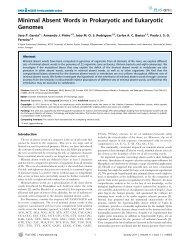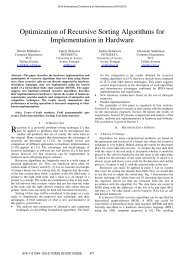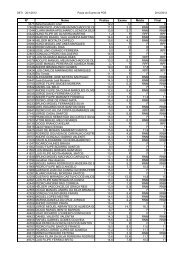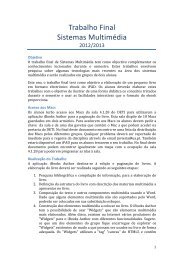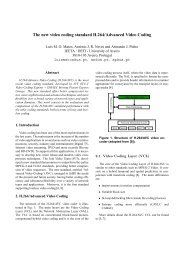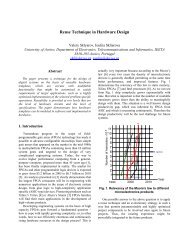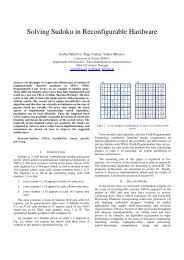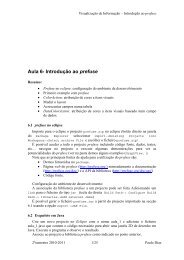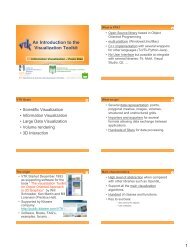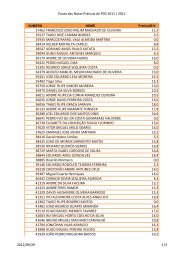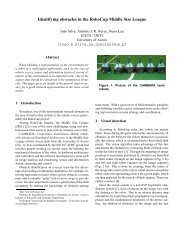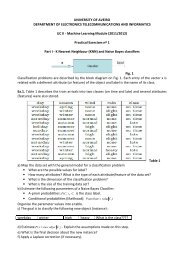DATA SHEET - IEETA
DATA SHEET - IEETA
DATA SHEET - IEETA
You also want an ePaper? Increase the reach of your titles
YUMPU automatically turns print PDFs into web optimized ePapers that Google loves.
Philips Semiconductors Product specification<br />
8-bit microcontroller with on-chip CAN P8xC592<br />
13.6.8.3 CRC Error<br />
To ensure the validity of a transmitted message all<br />
receivers perform a CRC check. Therefore, in addition to<br />
the (destuffed) information digits (Start-Of-Frame up to<br />
Data Field), every message includes some control digits<br />
(CRC Sequence; generated by the transmitting<br />
CAN-controller of the respective message) used for error<br />
detection.<br />
The code used by all CAN-controllers is a (shortened)<br />
BCH code, extended by a parity check and has the<br />
following attributes:<br />
• 127 bits as maximum length of the code.<br />
• 112 bits as maximum number of information digits<br />
(max. 83 bits are used by the CAN-controller).<br />
• Length of the CRC Sequence amounts to 15 bits.<br />
• Hamming distance d = 6.<br />
As a result, ‘(d−1)’ random errors are detectable (some<br />
exceptions exist).<br />
The CRC Sequence is determined (calculated) by the<br />
following procedure:<br />
1. The destuffed bit stream consisting of Start-Of-Frame<br />
up to the Data Field (if present) is interpreted as<br />
polynomial with coefficients 0 or 1.<br />
2. This polynomial is divided (modulo-2) by the following<br />
generator polynomial, which includes a parity check:<br />
fx () x14 x9 x8 x6 x5 x4 x2 = ( + + + + + + + x + 1)<br />
(x + 1) = 1100010110011001 B.<br />
3. The remainder of this polynomial division is the<br />
CRC Sequence.<br />
Burst errors are detected up to a length of 15<br />
[degree of f(x)]. Multiple errors (number of disturbed bits at<br />
least d = 6) are not detected with a residual error<br />
probability of 2 by CRC check only.<br />
15 – 3 10 5 – ( × )<br />
13.6.8.4 Form Error<br />
Form Errors result from violations of the fixed form of the<br />
following bit fields:<br />
• CRC Delimiter<br />
• Acknowledge Delimiter<br />
• End-Of-Frame<br />
• Error Delimiter<br />
• Overload Delimiter.<br />
During the transmission of these bit fields an error<br />
condition is recognized if a dominant bit level instead of a<br />
recessive one is detected.<br />
1996 Jun 27 61<br />
13.6.8.5 Acknowledgement Error<br />
This is detected by a transmitter whenever it does not<br />
monitor a dominant bit during the Acknowledge Slot.<br />
13.6.8.6 Error detection by an Error Flag from<br />
another CAN-controller<br />
The detection of an error is signalled by transmitting an<br />
Error Flag. An Active Error Flag causes a Stuff Error, a Bit<br />
Error or a Form Error at all other CAN-controllers.<br />
13.6.8.7 Error Detection Capabilities<br />
Errors which occur at all CAN-controllers (global errors)<br />
are 100% detected. For local errors, i.e. for errors<br />
occurring at some CAN-controllers only, the shortened<br />
BCH code, extended by a parity check, has the following<br />
error detection capabilities:<br />
• Up to five single Bit Errors are 100% detected, even if<br />
they are distributed randomly within the code.<br />
• All single Bit Errors are detected if their total number<br />
(within the code) is odd.<br />
• The residual error probability of the CRC check amounts<br />
to (3 × 10−5 ). As an error may be detected not only by<br />
CRC check but also by other detection processes<br />
described above the residual error probability is several<br />
magnitudes less than (3 × 10−5 ).<br />
13.6.9 ERROR CONFINEMENT DEFINITIONS<br />
13.6.9.1 Bus-OFF<br />
A CAN-controller which has too many unsuccessful<br />
transmissions, relative to the number of successful<br />
transmissions, will enter the Bus-OFF state. It remains in<br />
this state, neither receiving nor transmitting messages<br />
until the Reset Request bit is set LOW (absent) and both<br />
Error Counters set to 0 (see Section 13.6.10).<br />
13.6.9.2 Acknowledge<br />
A CAN-controller which has received a valid message<br />
correctly, indicates this to the transmitter by transmitting a<br />
dominant bit level on the bus during the Acknowledge Slot,<br />
independent of accepting or rejecting the message.<br />
13.6.9.3 Error-Active<br />
An error-active CAN-controller in its normal operating state<br />
is able to receive and to transmit normally and also to<br />
transmit an Active Error Flag (see Section 13.6.10).



